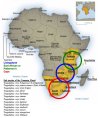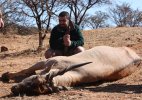I'm no expert in this field, but I had a run in with a very old eland a few years ago and I have done some research since.
There are two distinct species of eland: (1) the Lord Derby's Eland (
Tragelaphus derbianus) and (2) the Common Eland (
Tragelaphus oryx).
Lord Derby's is restricted to the west African and north central African regions: CAR, Cameroon, just into Chad and Sudan, and also Guinea, Senegal and the junction of neighbouring countries. The Common is has a wider range, across southern Africa and along the eastern side of the continent, perhaps as far up as the southern tip of Sudan and Ethiopia.
The Common Eland has three recognised subspecies if you do some basic research: Cape Eland in the south, Livingstone's in the north of their range, and East African along the north east of the range. As a matter of interest, the East African Eland is also known as Patterson's Eland. If you do a lot of research you will find reference to other "subspecies" but the taxonomic variance is largely that they are isolated populations (such as
Tragelaphus oryx kaufmanni in the Caprivi). They all fall under the species of Common Eland.
Now in response to your post, the Livingstone's is touted as being a heavier animal, and the vertical stripes down the sides are generally much more prevalent - that's it. My PH in Zim thought this made them a much more magnificent trophy than the often faded blue Cape Eland bulls from down south. Having said that, I have met PH's and landowners in South Africa who claim to have Livingstone's bloodlines in their eland; this often means the trophy fee is higher...
The last Cape Eland I hunted was a particularly large animal with distinct white stripes along his side. My PH and I had not been advised that there were any Livingstone's Eland on the property; when I took my exceptional bull, the land owner pointed out that I had shot a Livingstone's, not a Cape Eland. I quickly pointed out that there was more variation in the stripe patterns of his kudu population than his eland - end of discussion.
Similarly, when a PH in Zim pointed out a true Livingstone's in the wild while we hunted Gwayi, the bull looked more like a typical Cape Eland to me with its indistinct body markings.
The differences are there, but in keeping with their taxonomic rank, the differences are largely due to geographical distribution or isolation. Geographic isolation has no doubt brought about idiosyncrasies in each population that give them specific characteristics; differences in body size, horn size, face and leg markings and body colouration that are peculiar to each population.
I love the idea of collecting one of each of the three commonly described subspecies of the Common Eland - or how about one of each of the 13 subspecies you will find if you do a bit of research! that would need a big trophy room and a very understanding wife!
And any such collection will need a Lord Derby's...



